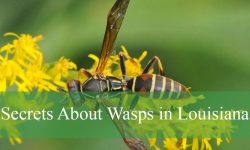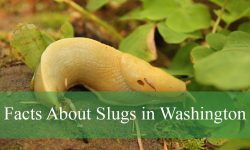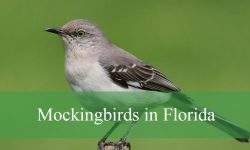Standing on a sun-warmed trail in a quiet Hawaiian forest, I heard the melodic warble of a Japanese White-eye and the distant call of a Nēnē. Palm fronds rustled above as a Red-footed Booby glided effortlessly along the coastline, and small finches flitted between flowering shrubs.
Each bird I spotted revealed a piece of Hawaii’s vibrant wildlife, from endemic species found nowhere else to introduced birds that have adapted beautifully to island life. Walking through these diverse habitats, it’s easy to see why Hawaii is a paradise not just for humans, but for birds as well.
Most Common Birds Found in Hawaii
Hawaiian Hawk (‘Io) (Buteo solitarius)
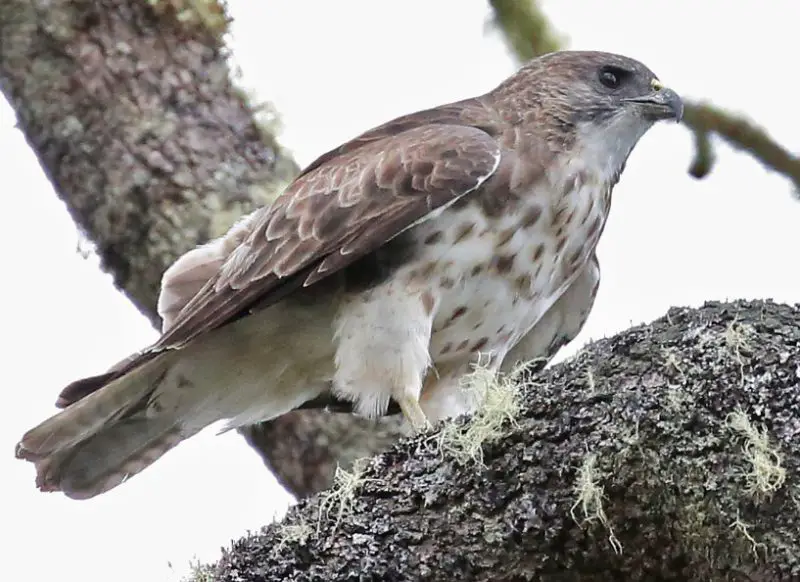
The Hawaiian Hawk, or ‘Io, is a medium-sized raptor found only in Hawaii, primarily on the Big Island. It displays two color morphs—dark and light. Light morph individuals have a white belly and underwings with a brown back, while dark morphs appear almost entirely dark brown. Adults typically measure 16 to 18 inches in length with a wingspan of about 40 inches, and they have sharp talons and hooked beaks suited for hunting.
The ‘Io is a skilled hunter, feeding on a wide range of prey including birds, insects, rodents, and occasionally carrion. It is often seen soaring high above open landscapes, using keen eyesight to detect movement below. During the breeding season, which occurs from March to September, pairs perform aerial displays, and both parents help care for the young. This bird’s call is a high-pitched “ee-oh,” from which it gets its Hawaiian name.
Its preferred habitats include native forests, agricultural lands, and even urban areas, making it one of the more adaptable Hawaiian endemics. The ‘Io holds cultural significance in Hawaiian tradition, symbolizing royalty and being considered a guardian spirit. Despite facing threats from habitat loss and human activity, it remains the only hawk species native to Hawaii and is protected as a threatened species.
Hawaiian Goose (Nēnē) (Branta sandvicensis)
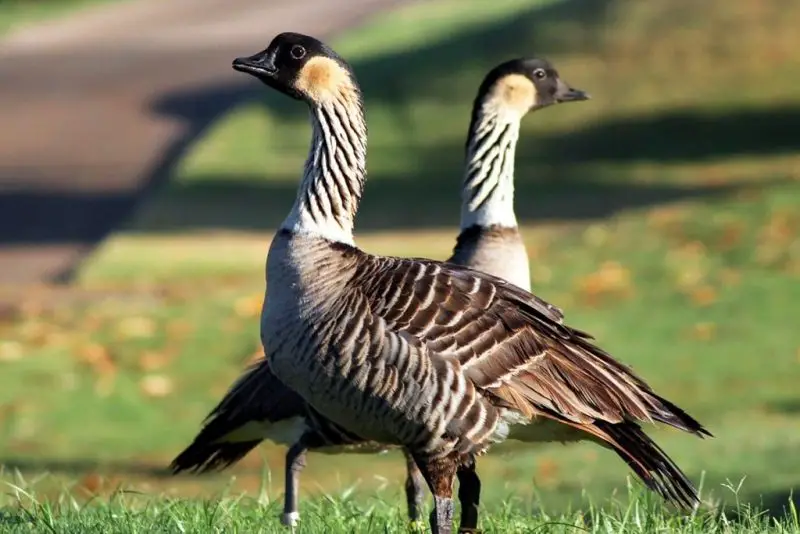
The Hawaiian Goose, locally known as the Nēnē, is the official state bird of Hawaii and one of the rarest geese in the world. It has a distinctive appearance with cream-colored cheeks, black facial markings, and deep brown barring on its neck. Unlike most geese, the Nēnē has reduced webbing between its toes, an adaptation that allows it to walk more easily on lava flows and rocky terrain. Adults typically measure around 25 inches in length, with a wingspan reaching up to 35 inches.
In terms of behavior, Nēnē are relatively sedentary compared to migratory geese, staying within the Hawaiian Islands year-round. They are primarily herbivorous, feeding on native grasses, seeds, flowers, and berries. Pairs are monogamous, often staying together for life, and nesting season generally occurs between November and June. They are known for their soft, low calls, which differ from the loud honking of mainland geese.
The Nēnē inhabits a variety of habitats in Hawaii, including shrublands, coastal dunes, grasslands, and the slopes of volcanoes, especially in areas like Haleakalā National Park on Maui and Hawaii Volcanoes National Park on the Big Island. Once on the brink of extinction, conservation efforts have helped restore their numbers, although they remain a vulnerable species and are protected under state and federal laws.
Hawaiian Coot (Fulica alai)
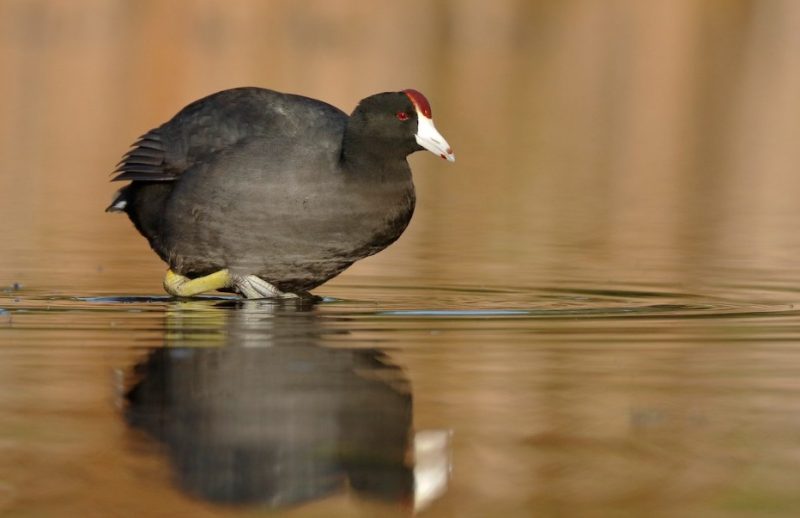
The Hawaiian Coot is a medium-sized waterbird with a rounded body, dark charcoal-gray plumage, and a distinctive white frontal shield on its forehead. This shield is often the easiest way to distinguish it from similar species. Adults typically measure around 14 inches in length, with a wingspan of about 24 inches, and have lobed toes that make them strong swimmers.
Hawaiian Coots are highly vocal and active, often seen swimming in ponds, marshes, and wetlands while diving for aquatic plants, small invertebrates, and seeds. They are territorial during the breeding season, which can occur year-round in Hawaii, though most nesting happens during wetter months. Nests are built from aquatic vegetation and float on the water’s surface, hidden among reeds and grasses.
Their habitat includes both freshwater and brackish wetlands across several Hawaiian Islands, such as O‘ahu, Maui, and Kaua‘i. They are considered endangered due to habitat destruction, introduced predators, and water pollution. Conservation programs focus on wetland restoration and predator control to help maintain stable populations.
Hawaiian Stilt (Himantopus mexicanus knudseni)
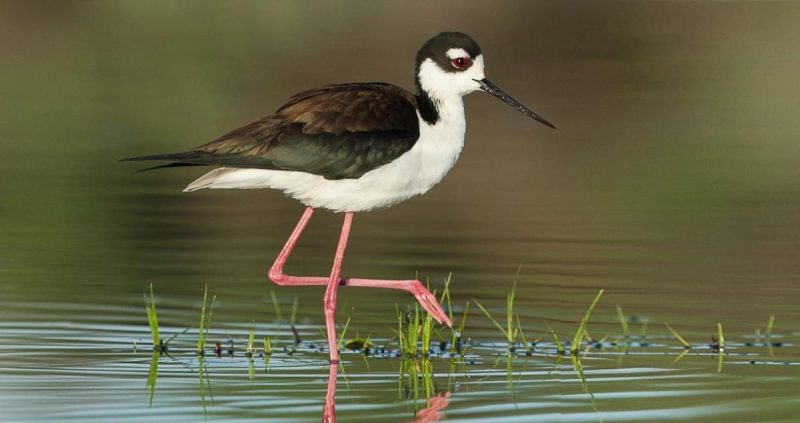
The Hawaiian Stilt is a tall, slender shorebird with striking black-and-white plumage, a long, thin black bill, and exceptionally long pink legs. Measuring about 15 to 17 inches in length with a wingspan of around 29 inches, this subspecies of the Black-necked Stilt is easily recognizable when wading in shallow waters. The contrasting dark back and white underparts make it particularly eye-catching.
They feed primarily on aquatic invertebrates, small fish, and crustaceans, using their long bill to probe mudflats and shallow wetlands. Hawaiian Stilts are active during the day and can be seen walking gracefully through marshes or flying in small groups. They are social birds outside the breeding season, but during nesting, they become territorial, often nesting in colonies for protection.
Their preferred habitats include coastal wetlands, fishponds, salt flats, and flooded fields across the main Hawaiian Islands. Like many native waterbirds, they face threats from habitat loss, predation by invasive species, and human disturbance. Conservation efforts include habitat management and predator control to help ensure their survival.
Hawaiian Gallinule (Gallinula galeata sandvicensis)

The Hawaiian Gallinule is a striking waterbird with dark plumage, a bright red frontal shield, and a yellow-tipped red bill. Adults average about 14 inches in length and have long toes that allow them to walk easily on floating vegetation. Unlike some other wetland birds, they are more secretive, often staying hidden among dense aquatic plants.
This species feeds on a variety of plant materials, seeds, insects, snails, and small aquatic creatures. Hawaiian Gallinules are known for their loud, cackling calls and can become quite vocal when defending their territory. Breeding can occur year-round, but peaks during the wetter months, with nests typically built in thick vegetation near the water’s edge.
They inhabit freshwater wetlands, taro patches, and occasionally brackish ponds, particularly on Kaua‘i and O‘ahu. The Hawaiian Gallinule is endangered, with threats including wetland destruction, predation by introduced mammals, and changes in water quality. Conservation measures focus on protecting and restoring wetland habitats to ensure the continued survival of this unique subspecies.
Hawaiian Petrel (Pterodroma sandwichensis)
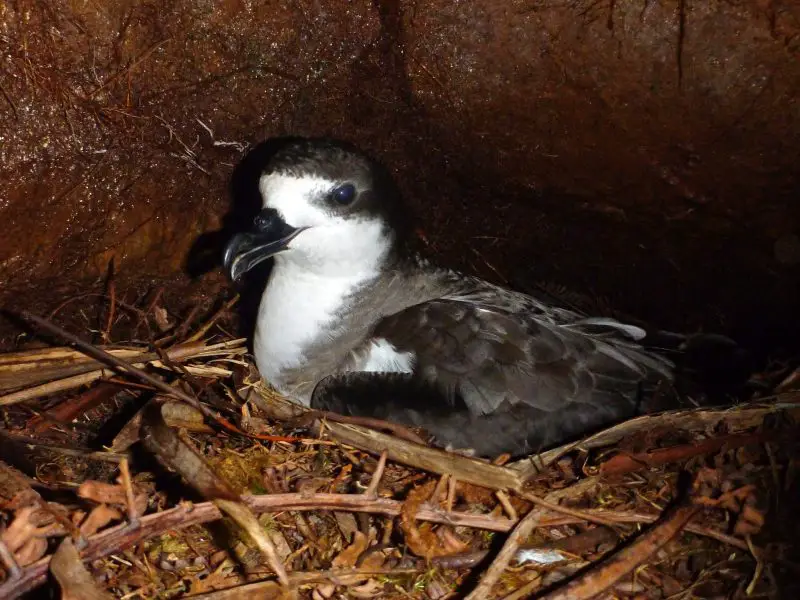
The Hawaiian Petrel is an endangered seabird known for its elegant flight and long-distance migrations across the Pacific Ocean. It has a dark gray-brown back, white underparts, and a distinctive dark cap that extends below the eyes. Adults typically measure about 16 inches in length with a wingspan of roughly 36 inches, giving them a streamlined build ideal for gliding over open seas. Their hooked bills and tubular nostrils are adaptations for their pelagic lifestyle.
This species spends most of its life at sea, feeding on squid, fish, and crustaceans, which they capture by plunge-diving. Hawaiian Petrels are nocturnal at their breeding colonies, a behavior that helps them avoid predators. They nest in burrows or rock crevices high on volcanic slopes, with breeding occurring from late spring through summer. Both parents share the responsibility of incubating the single egg and feeding the chick.
Hawaiian Petrels breed on several islands, including Maui, Hawai‘i, and Kaua‘i, often in remote and rugged terrain. They face threats from introduced predators like cats and mongooses, light pollution that disorients fledglings, and habitat degradation. Conservation programs focus on predator control, light reduction near colonies, and habitat protection to help boost their numbers.
Newell’s Shearwater (Puffinus newelli)

Newell’s Shearwater is a medium-sized seabird endemic to Hawaii, with glossy black upperparts, white underparts, and a sharp demarcation between the two colors. It has a slender body, a short tail, and a narrow, hooked bill that measures around 1.5 inches. Adults are typically about 13 inches long with a wingspan close to 30 inches, built for efficient, rapid wingbeats over ocean waters.
They feed mainly on small fish and squid, catching prey at the ocean’s surface or by shallow plunge-diving. Newell’s Shearwaters are known for their rapid, direct flight and are often seen in small feeding flocks. At breeding colonies, they are active at night to avoid predators, and they nest in burrows dug into steep mountain slopes. Breeding season generally begins in late spring, and chicks fledge by the end of summer or early fall.
Their primary nesting sites are on the islands of Kaua‘i, Maui, and Hawai‘i, with foraging taking them far offshore. The species is listed as threatened due to habitat loss, introduced predators, and collisions with power lines and buildings during nocturnal flights. Conservation measures include burrow protection, predator control, and reducing artificial light near nesting areas.
Laysan Albatross (Phoebastria immutabilis)
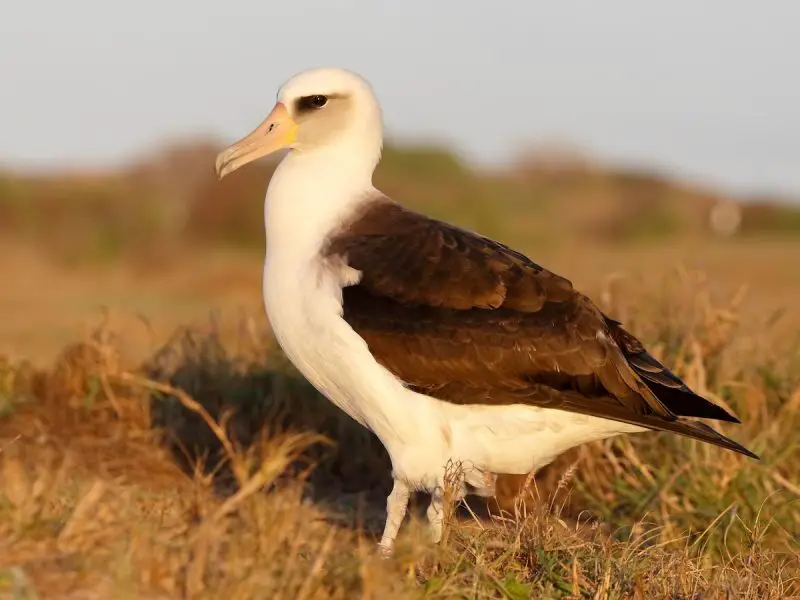
The Laysan Albatross is a large seabird with a graceful wingspan reaching up to 80 inches, making it an expert glider over the open ocean. Adults have a mostly white head, neck, and underparts, contrasting with dark gray-brown upper wings and back. Their bills are pale pink with a dark tip, and they have dark eye markings that give them a gentle expression.
These albatrosses feed primarily on squid, fish, and crustaceans, often following fishing vessels in search of discarded bycatch. They are highly social at breeding colonies, engaging in elaborate courtship dances that involve bill clacking, head bobbing, and synchronized movements. They lay a single egg, with both parents sharing incubation duties for about two months before the chick hatches.
Laysan Albatrosses breed on several Hawaiian islands, especially Midway Atoll and Laysan Island, as well as some nesting sites on Kaua‘i and O‘ahu. While their population is relatively stable compared to other albatross species, they still face threats from plastic pollution, fishing gear entanglement, and habitat disturbance. Protected breeding areas and international conservation agreements help safeguard their future.
Black-footed Albatross (Phoebastria nigripes)
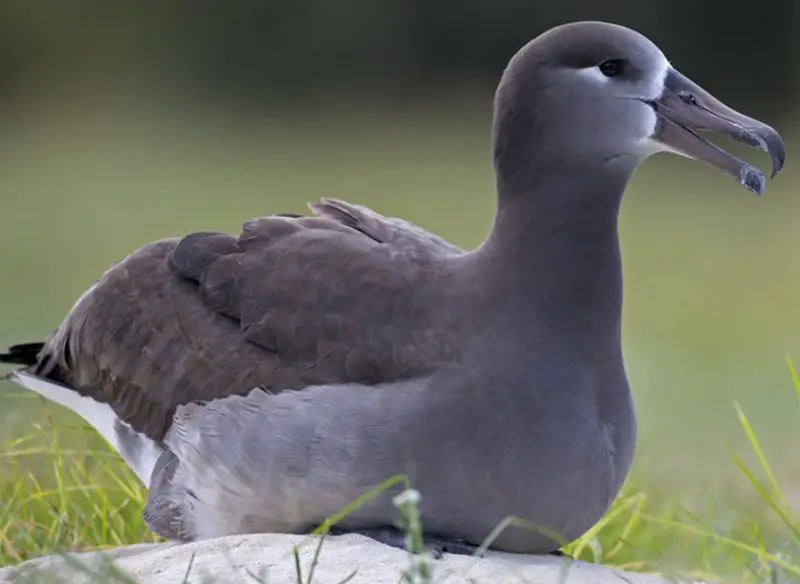
The Black-footed Albatross is slightly smaller than the Laysan Albatross, with a wingspan of around 76 inches. It has dark chocolate-brown plumage overall, with lighter shading on the face and a white ring around the base of the bill. As its name suggests, its legs and feet are entirely black. The long, narrow wings make it a master of dynamic soaring over vast stretches of ocean.
This species feeds mainly on squid, flying fish eggs, and other surface-dwelling marine life. Black-footed Albatrosses often feed far from shore, returning to land only during the breeding season. They perform complex courtship rituals similar to other albatrosses, and both parents take turns incubating their single egg and later feeding the chick with regurgitated food.
They nest primarily on the Northwestern Hawaiian Islands, including Midway Atoll and Laysan Island. Threats include bycatch from longline fishing, ingestion of marine plastics, and climate change affecting prey availability. Conservation efforts focus on reducing fishing-related mortality and protecting nesting sites.
Red-footed Booby (Sula sula)
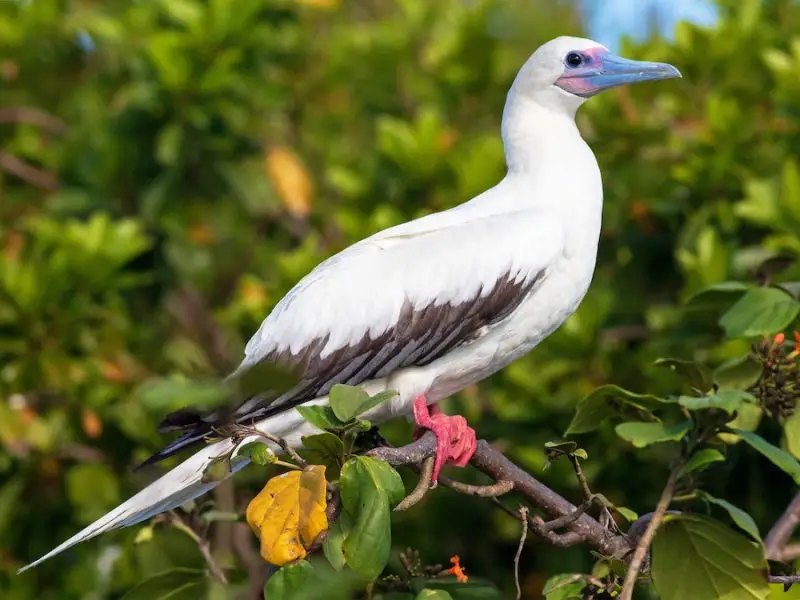
The Red-footed Booby is the smallest of the booby species, measuring about 28 inches in length with a wingspan of around 55 inches. Despite its name, this seabird has several color morphs, including white, brown, and mixed plumages, but all have bright red legs and feet. They have a pale blue bill with a pinkish base, and their streamlined body shape aids in swift, agile flight.
Red-footed Boobies are exceptional divers, plunging from great heights into the ocean to catch fish and squid. They often hunt in groups, sometimes alongside dolphins or tuna that drive prey toward the surface. These birds are highly social at nesting colonies, where they build nests of twigs and leaves in coastal trees or shrubs.
In Hawaii, they breed on islands such as Kure Atoll, Midway Atoll, and Laysan Island, with smaller colonies on the main islands. They are more abundant than some other seabirds but still face threats from habitat disturbance, overfishing of prey species, and climate change. Protected breeding areas and marine conservation zones help maintain healthy populations.
Brown Booby (Sula leucogaster)
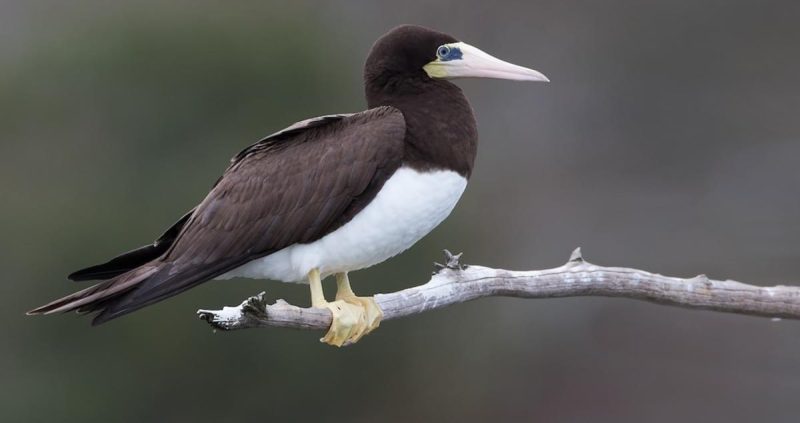
The Brown Booby is a large seabird recognized for its striking brown-and-white plumage and streamlined body built for fast, powerful flight. Adults typically measure around 30 inches in length, with a wingspan of about 55 inches. They have a dark chocolate-brown head, back, and upper breast, contrasting with a bright white belly. Their sharp, pointed bill and strong, wedge-shaped tail are well adapted for their diving lifestyle.
These birds are expert hunters, diving from heights of up to 50 feet to catch fish and squid near the ocean surface. They often forage in small groups, taking advantage of schools of fish driven up by predators like dolphins. Brown Boobies nest in colonies, building simple ground nests from sticks, grass, and other debris, usually on remote islands. Both parents take turns incubating the eggs and feeding the chicks.
In Hawaii, Brown Boobies are found on offshore islets, cliffs, and sandy beaches, particularly in the Northwestern Hawaiian Islands. While they are not currently endangered, they face threats from human disturbance, plastic ingestion, and fishing gear entanglement. Protected nesting areas and reduced fishing impacts are important for maintaining their populations.
Great Frigatebird (Fregata minor)
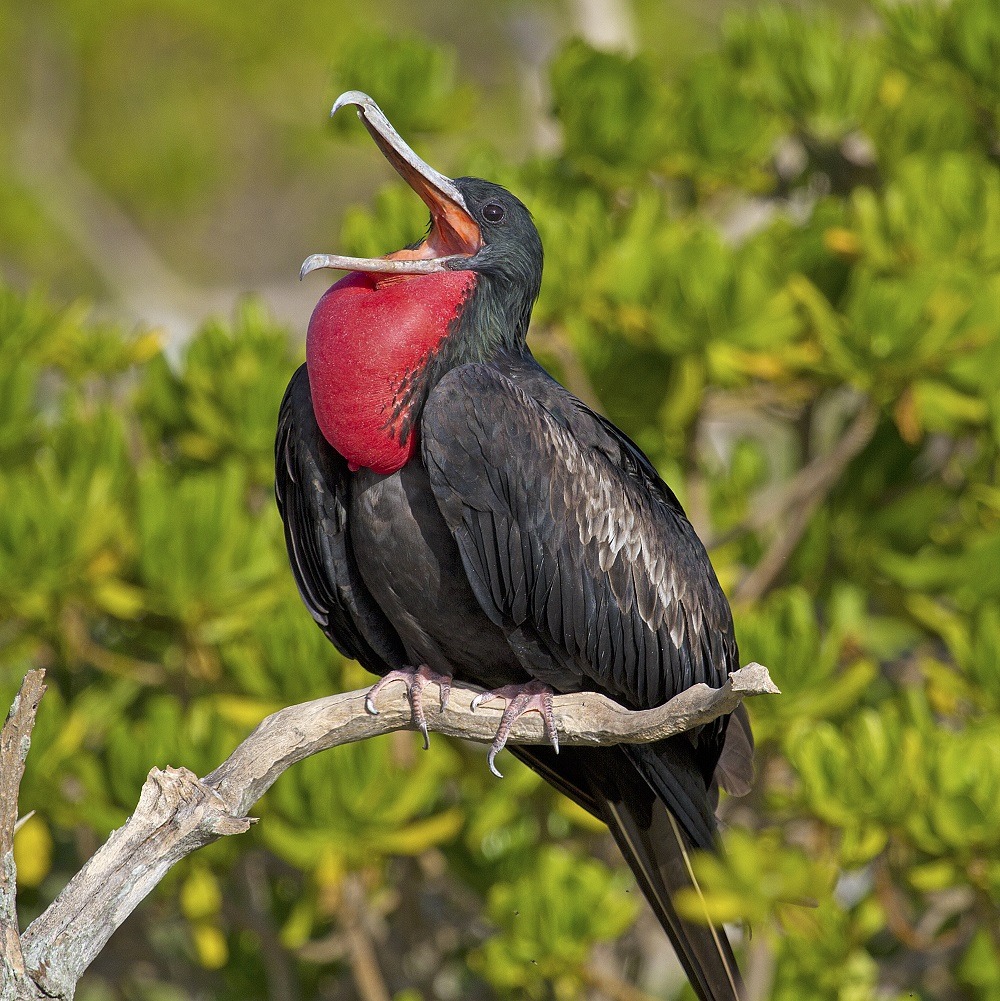
The Great Frigatebird is a large seabird with an impressive wingspan reaching up to 90 inches, making it one of the most efficient gliders over the ocean. Adults have glossy black plumage, long pointed wings, and deeply forked tails. Males are distinguished by their large red throat pouch, which they inflate during courtship displays, while females have a white breast and lower belly.
Unlike diving seabirds, Great Frigatebirds feed by snatching prey—such as flying fish, squid, and small seabirds—from the surface or even mid-air. They are also known for kleptoparasitism, chasing other seabirds to steal their catch. These birds breed in large colonies on remote islands, where they build stick nests in low shrubs or trees.
In Hawaii, they are common in the Northwestern Hawaiian Islands and can often be seen soaring effortlessly above the coastlines of the main islands. Threats include habitat loss at breeding sites, overfishing of prey species, and plastic pollution. Their mastery of flight and unique breeding behaviors make them one of the most fascinating seabirds in Hawaiian waters.
White Tern (Gygis alba)
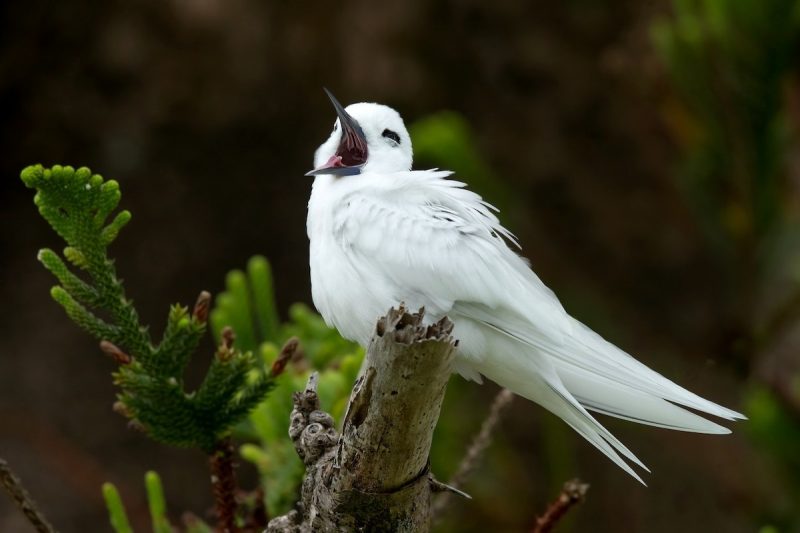
The White Tern, often called the “fairy tern” for its delicate beauty, is a small, pure white seabird with a slender black bill and large dark eyes. Measuring about 12 inches in length with a wingspan of 28 inches, it is known for its graceful flight and almost ethereal appearance. Its all-white plumage makes it easy to identify against the blue ocean or green coastal foliage.
White Terns feed mainly on small fish and squid, which they catch by hovering and dipping into the water’s surface. One of their most unusual behaviors is their nesting method—they do not build traditional nests but instead lay their single egg directly on a bare tree branch or ledge. Parents take turns incubating and feeding the chick until it can fly.
In Hawaii, White Terns are especially common in Honolulu on O‘ahu, where they are a beloved urban bird. They also occur on other islands and atolls across the state. While not currently threatened, they benefit from the protection of suitable nesting trees and reduced disturbance from humans and predators.
Sooty Tern (Onychoprion fuscatus)
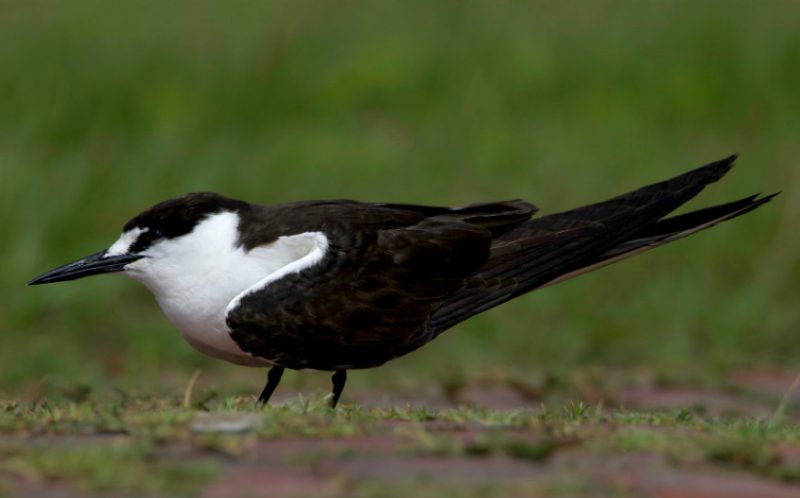
The Sooty Tern is a medium-sized seabird with sleek black upperparts, white underparts, and a sharp white forehead that extends above the eyes. Adults measure around 17 inches in length with a wingspan of 34 inches. Their slender wings and forked tail give them an elegant, streamlined profile in flight.
Sooty Terns spend most of their lives at sea, rarely coming to shore except to breed. They feed primarily on small fish and squid, catching prey in flight while skimming just above the ocean surface. During the breeding season, they nest in enormous colonies on sandy or rocky islands, laying eggs directly on the ground. Both parents share incubation and chick-rearing duties.
In Hawaii, large colonies can be found on remote islands in the Northwestern Hawaiian chain, such as French Frigate Shoals. They are well adapted to a pelagic lifestyle but face threats from rising sea levels, storms that destroy nesting sites, and introduced predators. Protected breeding grounds are vital for sustaining their populations.
Brown Noddy (Anous stolidus)
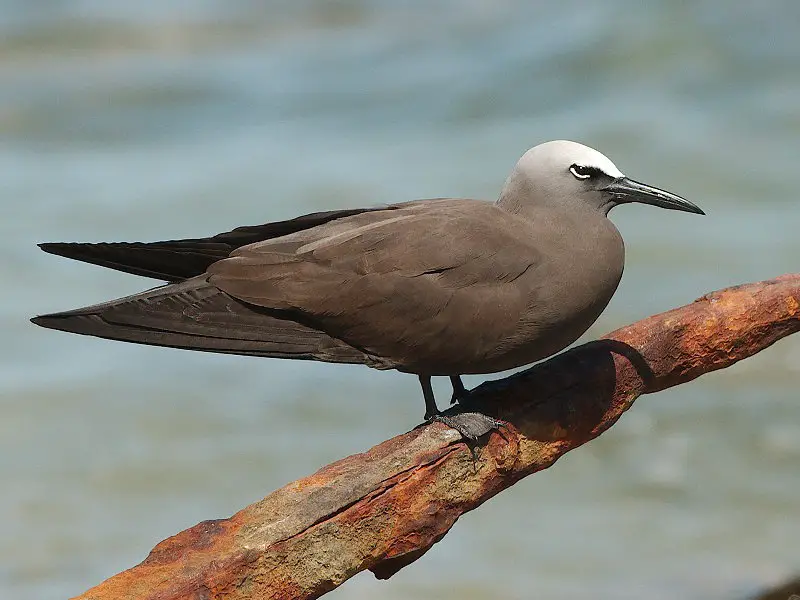
The Brown Noddy is a medium-sized tern with dark chocolate-brown plumage, a pale gray cap, and a slender black bill. Measuring about 15 inches long with a wingspan of 30 inches, it is easily distinguished from other terns by its darker overall coloration. The name “noddy” comes from their characteristic head-nodding displays during courtship.
Brown Noddies feed mainly on small fish and squid, catching prey by dipping into the water while in flight. They are often seen foraging near schools of tuna or dolphins, which push prey to the surface. These birds nest in large colonies, usually building nests in shrubs, low trees, or rocky ledges using twigs, grass, and seaweed.
In Hawaii, they are found on both the main and Northwestern Hawaiian Islands, favoring offshore islets and protected coastal areas. Although not endangered, they are vulnerable to habitat disturbance, plastic pollution, and overfishing of their prey. Conservation efforts that protect nesting sites and marine ecosystems help keep their numbers stable.
Black Noddy (Anous minutus)

The Black Noddy is a sleek seabird with dark, sooty-brown plumage that appears almost black in certain lighting. It is smaller than the Brown Noddy, measuring about 14 inches in length with a wingspan of around 30 inches. Its most distinctive feature is the contrasting white cap on its head, which extends from the forehead to the nape, and its slender, pointed black bill.
Black Noddies feed primarily on small fish and squid, which they capture by dipping into the water’s surface during flight. They are skilled fliers, often foraging near coral reefs and inshore waters where prey is abundant. These birds are highly social, nesting in large colonies where they build compact nests from leaves, twigs, and other vegetation, often high in coastal trees.
In Hawaii, Black Noddies are found on both the main and Northwestern Hawaiian Islands, especially on offshore islets with limited human disturbance. While their population is considered stable, they are still vulnerable to habitat loss, introduced predators, and changes in marine food availability. Protected island habitats play a key role in their conservation.
Pacific Golden-Plover (Pluvialis fulva)
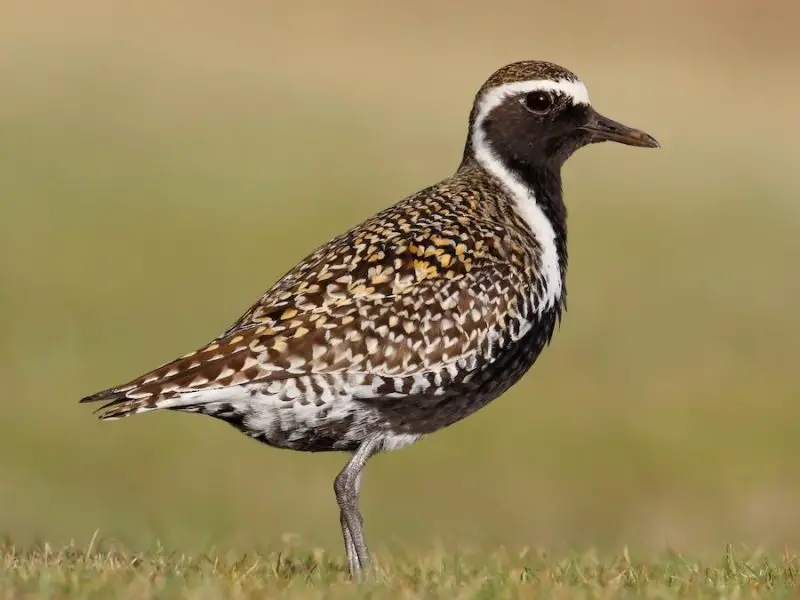
The Pacific Golden-Plover is a striking shorebird known for its long migrations, traveling thousands of miles between breeding grounds in the Arctic and wintering areas in Hawaii. In breeding plumage, it displays a black face, throat, and belly bordered by a bright white stripe, with gold-flecked brown and black upperparts. In nonbreeding plumage, it is more subdued in color, with mottled brown and golden tones. Adults are about 10 inches in length with a wingspan of 24 inches.
These plovers feed on insects, worms, crustaceans, and small mollusks, foraging by running across open ground and quickly picking prey from the surface. They are alert and active, often pausing to scan their surroundings before moving again. In Hawaii, they are commonly seen on lawns, golf courses, beaches, and grassy fields during the winter months.
Pacific Golden-Plovers, known locally as “Kōlea,” are admired in Hawaiian culture for their remarkable navigation skills and seasonal return. They arrive in the islands around late August and depart for their Arctic breeding grounds in late April or early May. Although not currently threatened, they face challenges from habitat loss and climate change affecting both their breeding and wintering areas.
Ruddy Turnstone (Arenaria interpres)

The Ruddy Turnstone is a small, sturdy shorebird with a distinctive patterned plumage. In breeding season, it has bright chestnut patches on its back, a black-and-white face pattern, and a white belly, while in nonbreeding plumage, it is more muted with browns and grays. Adults measure about 9 inches in length with a wingspan of around 22 inches. Their short, wedge-shaped bill is perfectly adapted for flipping over stones, shells, and seaweed in search of food.
They feed on a wide variety of invertebrates, including insects, mollusks, and crustaceans, as well as scavenging from carrion and human food scraps. Ruddy Turnstones are highly energetic foragers, often moving in small groups along shorelines and tidal flats. During migration, they can cover vast distances, making them a common sight in coastal areas worldwide.
In Hawaii, they are primarily winter visitors, arriving in late summer or early fall and departing in spring. They frequent rocky shorelines, sandy beaches, and coastal wetlands. While their global population is stable, they rely on healthy coastal habitats free from disturbance and pollution to maintain strong numbers.
Wandering Tattler (Tringa incana)
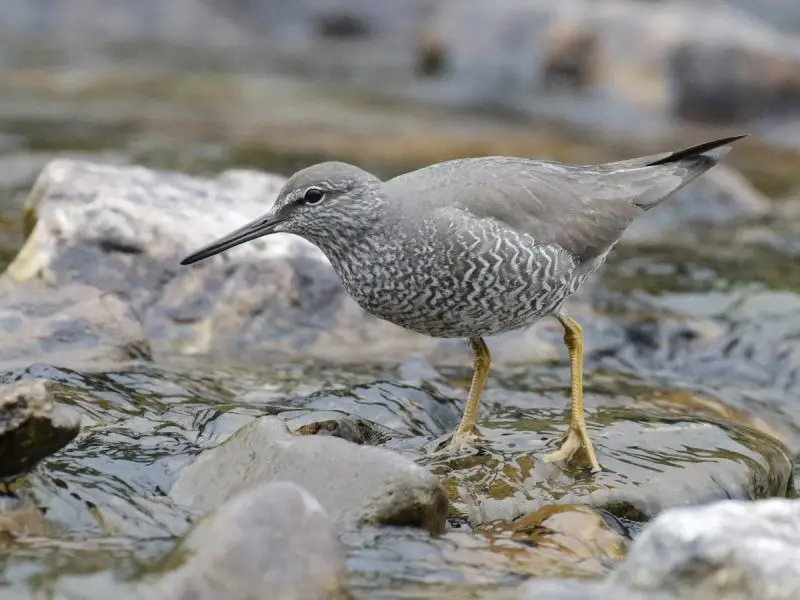
The Wandering Tattler is a medium-sized shorebird with a plain gray back, lighter underparts, and distinctive dark barring on the underparts during the breeding season. In nonbreeding plumage, it appears uniformly gray above with white below. Adults are about 10–11 inches long with a wingspan of 23 inches. One of its key identification features is its constant tail-bobbing behavior while foraging.
These birds feed on insects, marine worms, small crustaceans, and mollusks, foraging along rocky shorelines and tidal pools. They are solitary or occur in small groups, often perching on rocks or darting quickly across wet sand. Their high-pitched, whistled calls are often heard before they are seen.
In Hawaii, Wandering Tattlers are winter visitors, arriving from their breeding grounds in Alaska and Canada. They are most often found along rocky coasts and less frequently on sandy beaches. Though not threatened, they depend on clean, undisturbed coastal habitats for their survival during migration and wintering periods.
Cattle Egret (Bubulcus ibis)
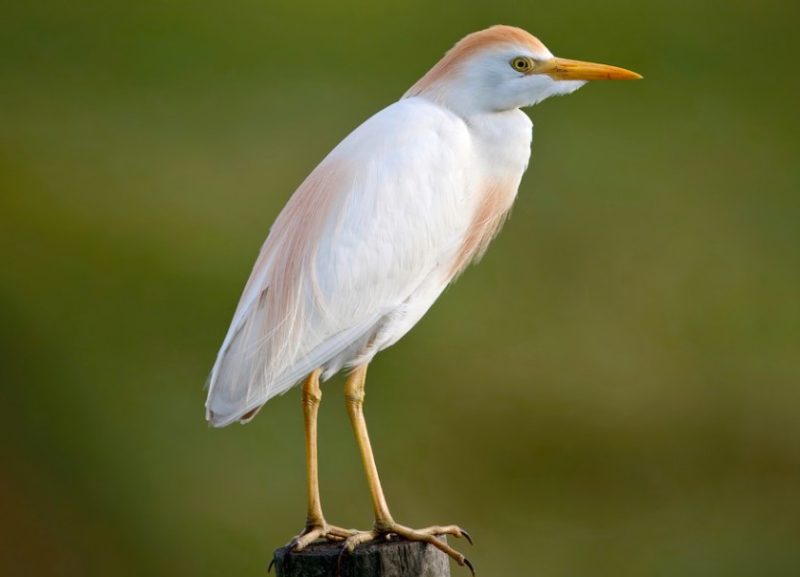
The Cattle Egret is a small, stocky heron with mostly white plumage, a short yellow bill, and yellow legs. During the breeding season, adults develop golden-orange plumes on their head, chest, and back, giving them a more colorful appearance. They are about 19 inches long with a wingspan of 35 inches. Unlike many herons, they are often found away from water.
Their diet includes insects, frogs, small reptiles, and other small animals, often caught while following grazing cattle or other large animals that flush prey from the grass. Cattle Egrets are highly adaptable, foraging in pastures, agricultural fields, and even urban parks. They nest in colonies, building platform nests in trees or shrubs near water.
In Hawaii, they are a common sight in open fields and agricultural areas on all major islands. Originally from Africa, they naturally expanded their range to the Americas and the Pacific, arriving in Hawaii in the late 1900s. While they are not endangered, they can impact native species by competing for food and preying on small animals in sensitive habitats.
Black-crowned Night-Heron (Nycticorax nycticorax)
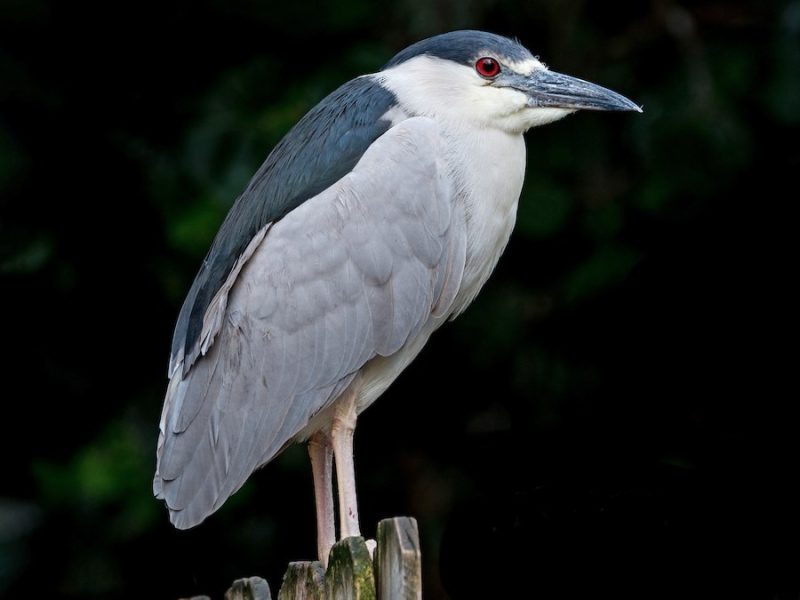
The Black-crowned Night-Heron is a medium-sized wading bird with a distinctive stocky build, short neck, and relatively short legs compared to other herons. Adults have pale gray wings and underparts, black caps and backs, and striking red eyes. They measure about 25 inches in length with a wingspan of 45 inches. Juveniles are mottled brown with streaked underparts, gradually acquiring adult plumage over several years.
Unlike most herons, these birds are primarily nocturnal, foraging at dusk and throughout the night. They feed on fish, amphibians, crustaceans, insects, and small mammals, often standing still at the water’s edge before striking quickly at prey. During the day, they are typically seen roosting quietly in trees or shrubs near wetlands.
In Hawaii, Black-crowned Night-Herons inhabit freshwater and brackish wetlands, ponds, and coastal lagoons on all main islands. Known locally as “ʻAukuʻu,” they are native to the islands and remain fairly common, though they face threats from habitat loss and wetland degradation. Their adaptability and broad diet have allowed them to persist in a range of environments.
Rock Pigeon (Columba livia)
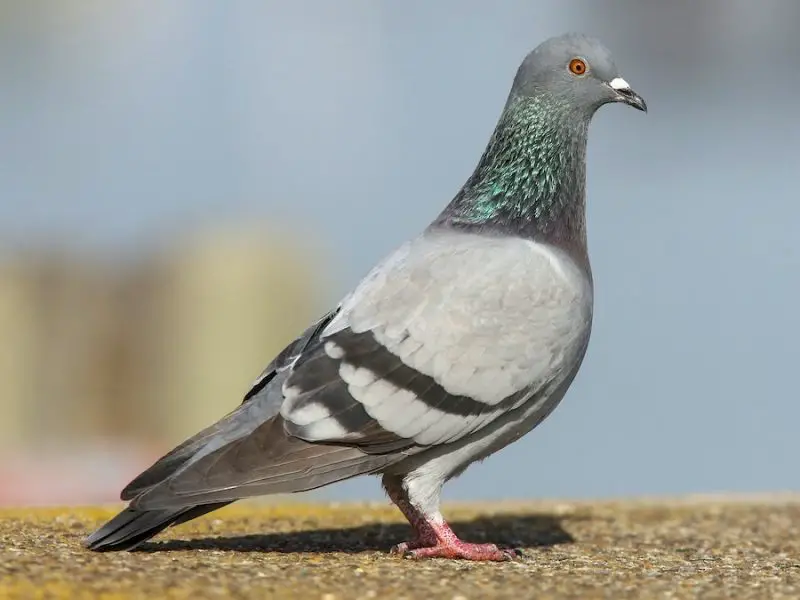
The Rock Pigeon is a familiar sight in urban and rural areas of Hawaii, often seen in parks, streets, and around buildings. They vary widely in color but typically have gray bodies, two black wing bars, and iridescent feathers on the neck and chest. Adults measure around 13 inches long with a wingspan of 25 inches. They have strong, direct flight patterns and are highly adaptable to human environments.
These pigeons feed mainly on seeds and grains, but they also consume scraps of human food. They forage on the ground in flocks and can be quite bold around people. Rock Pigeons breed year-round in Hawaii, nesting on building ledges, bridges, and cliffs, where they raise multiple broods annually.
Originally native to Europe, North Africa, and western Asia, Rock Pigeons were introduced to Hawaii and have become well established. While they are abundant, large populations can cause problems in urban settings due to droppings and nesting habits. Despite this, they remain an iconic bird in city landscapes.
Spotted Dove (Spilopelia chinensis)

The Spotted Dove is a medium-sized dove with a distinctive black collar spotted with white on the back of its neck. Its plumage is soft brown with a pinkish wash on the chest, and it has a long, rounded tail edged in white. Adults measure about 12 inches in length with a wingspan around 18 inches. Their gentle cooing calls are a familiar sound in many Hawaiian neighborhoods.
These doves feed mainly on seeds, grains, and small fruits, foraging on the ground in open areas, gardens, and roadsides. They are often seen alone or in pairs, moving with a slow, deliberate walk while pecking at the ground. Spotted Doves nest in simple twig platforms, usually in trees or shrubs, and may breed several times a year in Hawaii’s warm climate.
Native to South and Southeast Asia, Spotted Doves were introduced to Hawaii in the late 1800s and are now common on all major islands. They adapt easily to both urban and rural settings, thriving in parks, farmland, and suburban gardens.
Zebra Dove (Geopelia striata)
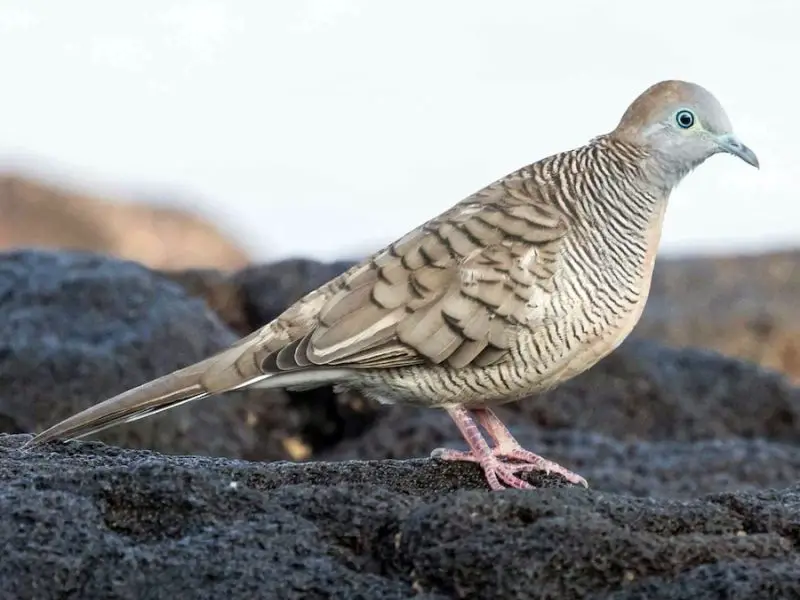
The Zebra Dove is a small, slender dove known for its delicate, barred plumage in shades of brown and gray, giving it a zebra-like pattern. It has a long tail and pale blue skin around the eyes, with adults measuring about 8 inches in length. Its soft, rapid cooing is a common background sound in Hawaii’s towns and gardens.
They feed on small seeds and grains, often foraging quietly on the ground in pairs or small family groups. Zebra Doves are gentle in behavior and tend to be less wary of humans than some other dove species. Their nests are small and flimsy, built from twigs and placed in shrubs, trees, or even sheltered man-made structures.
Originally from Southeast Asia, Zebra Doves were introduced to Hawaii in the early 20th century and have spread throughout the islands. They are especially abundant in urban and suburban areas, where they add a peaceful charm to gardens and streets.
Common Myna (Acridotheres tristis)
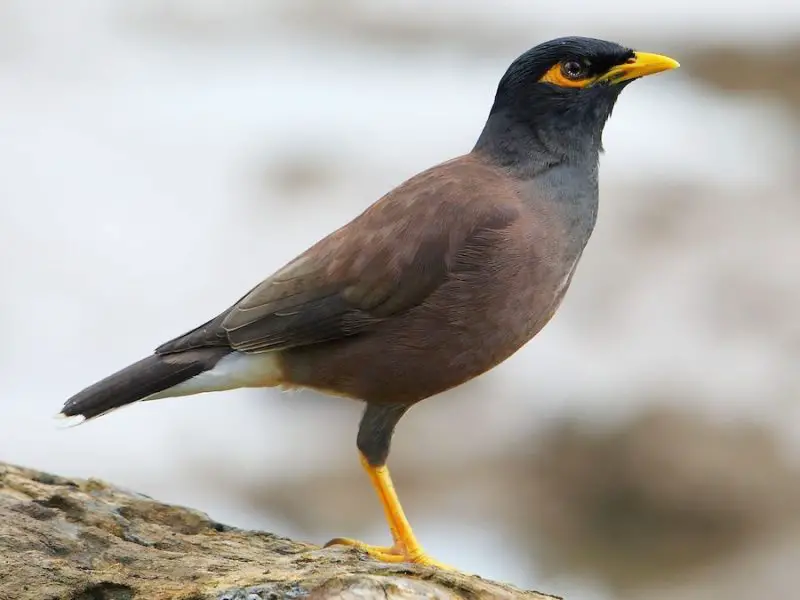
The Common Myna is a medium-sized, highly adaptable bird with brown body plumage, a black head, and bright yellow bill, legs, and eye patches. Measuring about 9 inches in length, it has strong legs and a confident stance. Its white wing patches are visible in flight, giving it a distinctive appearance.
Mynas are opportunistic feeders, consuming insects, fruits, grains, and human food scraps. They are intelligent and bold, often foraging in open areas near human activity. Common Mynas are known for their loud, varied calls and can mimic other birds and even human-made sounds. They are aggressive in defending their nesting sites, often displacing native birds.
Introduced to Hawaii in the 19th century to control insect pests, Common Mynas have since become widespread on all major islands. While they are entertaining to watch, they are considered invasive due to their competition with native species for nesting sites and food resources.
House Finch (Haemorhous mexicanus)
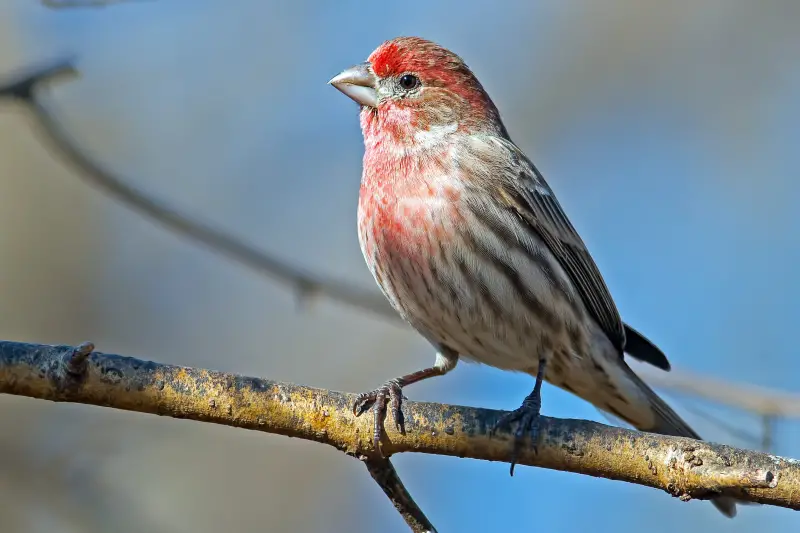
The House Finch is a small, sociable songbird with a stout, conical bill well-suited for cracking seeds. Males are easily recognized by their red forehead, throat, and chest, though the intensity of the color can range from orange to yellow depending on diet. Females lack red coloration and are streaked brown and gray overall. Adults measure about 5 to 6 inches in length with a wingspan of around 9 to 10 inches.
House Finches feed mainly on seeds, fruits, and buds, occasionally taking small insects. They are often seen in flocks, especially outside the breeding season, foraging in trees, shrubs, and on the ground. Their cheerful, warbling song is a common sound in gardens and urban areas.
Introduced to Hawaii in the late 1800s, House Finches are now widespread across all major islands, thriving in both rural and urban environments. They readily nest in trees, shrubs, and even building ledges, making them one of the most adaptable songbirds in the islands.
Northern Cardinal (Cardinalis cardinalis)
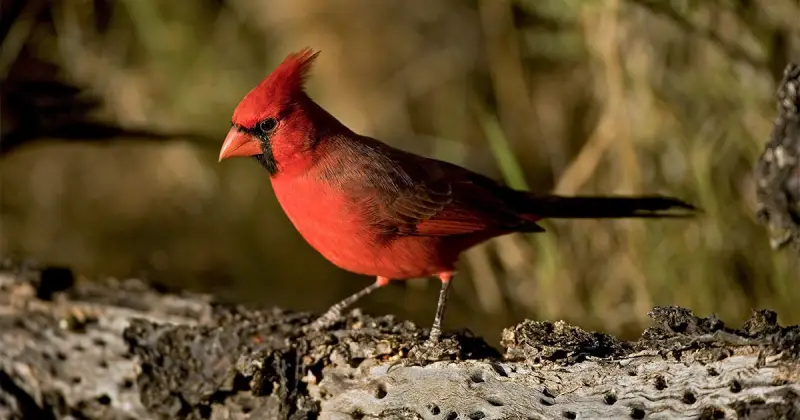
The Northern Cardinal is a striking bird with a crest atop its head and a thick, orange-red bill. Males are brilliant red all over, while females are warm brown with reddish tinges on the wings, tail, and crest. Both sexes have a black face mask surrounding the bill. They are medium-sized songbirds, measuring about 8 to 9 inches in length with a wingspan of 10 to 12 inches.
Cardinals feed primarily on seeds, fruits, and insects, using their strong bills to crack hard shells. They are often found in pairs, with males known for their loud, clear whistles and territorial behavior during breeding season. Their nests are cup-shaped and usually placed in dense shrubs or trees.
Brought to Hawaii in the late 1920s, Northern Cardinals have adapted well to gardens, parks, and forest edges across the islands. They are appreciated for their vivid coloration and beautiful songs, which add a splash of brightness to the Hawaiian bird community.
Red-crested Cardinal (Paroaria coronata)
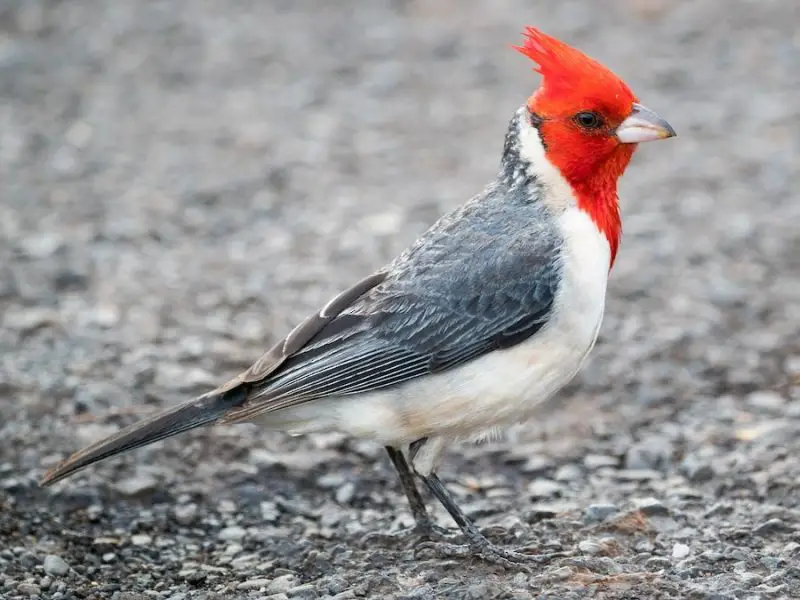
The Red-crested Cardinal is a distinctive bird with a bright red head, crest, and throat, contrasted by a gray back and white underparts. Its bold appearance makes it easy to recognize, even from a distance. Adults measure about 7.5 inches in length, with a medium build and strong legs for foraging on the ground.
They feed on seeds, fruits, and insects, often foraging in open areas, lawns, and parklands. Red-crested Cardinals are social and may be seen in small groups, particularly outside the breeding season. Their calls are a mix of whistles and chirps, and they often perch conspicuously in shrubs or small trees.
Introduced to Hawaii from South America in the 1930s, Red-crested Cardinals are now common on all main islands, especially in urban parks and coastal areas. Their bright plumage and friendly behavior make them a favorite among birdwatchers and residents alike.
Yellow-billed Cardinal (Paroaria capitata)
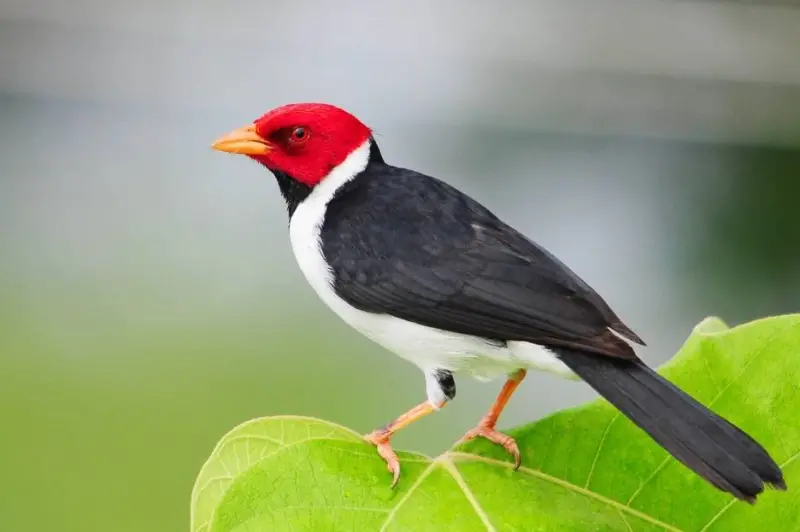
The Yellow-billed Cardinal is closely related to the Red-crested Cardinal but has distinct differences in appearance. It features a red head and throat, a black upper body, white underparts, and, as its name suggests, a bright yellow bill. Adults are about 6.5 inches long, slightly smaller than their red-crested relatives.
They feed mainly on seeds, insects, and fruits, foraging on the ground or in low vegetation. Yellow-billed Cardinals are often found in small flocks, especially near water sources. They are active and alert birds, with sharp, chipping calls.
Native to South America, Yellow-billed Cardinals were introduced to Hawaii in the early 1970s. They are now established primarily on the Big Island, often inhabiting open woodlands, parks, and areas near streams and ponds. Their vivid head and bill make them a striking sight in the landscape.
Japanese White-eye (Zosterops japonicus)
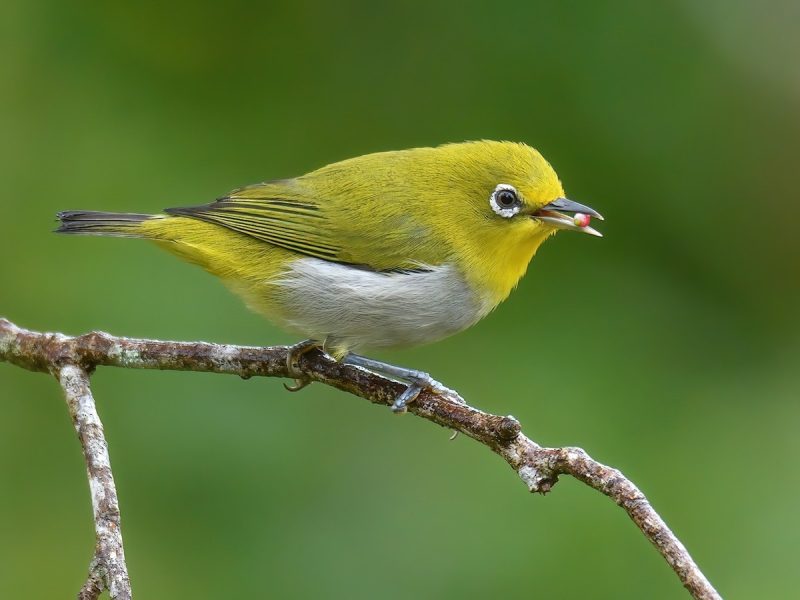
The Japanese White-eye is a small, active songbird with olive-green upperparts, yellow throat and chest, and a distinctive white eye-ring that gives it its name. Adults measure about 4 inches in length, making them one of the smallest birds in Hawaii. Their short, thin bills are adapted for feeding on nectar, fruits, and small insects.
These birds are agile foragers, often seen flitting through foliage in small, noisy flocks. They play a role in pollination, transferring pollen as they feed from flowers. Their high-pitched calls and soft warbling songs are common sounds in forests and gardens alike.
Introduced from Japan in the 1920s, Japanese White-eyes are now one of the most abundant birds in Hawaii, found from coastal areas to high mountain forests. While they are beautiful and adaptable, their success has had ecological impacts, including competition with native Hawaiian birds for food and habitat.
Java Sparrow (Padda oryzivora)
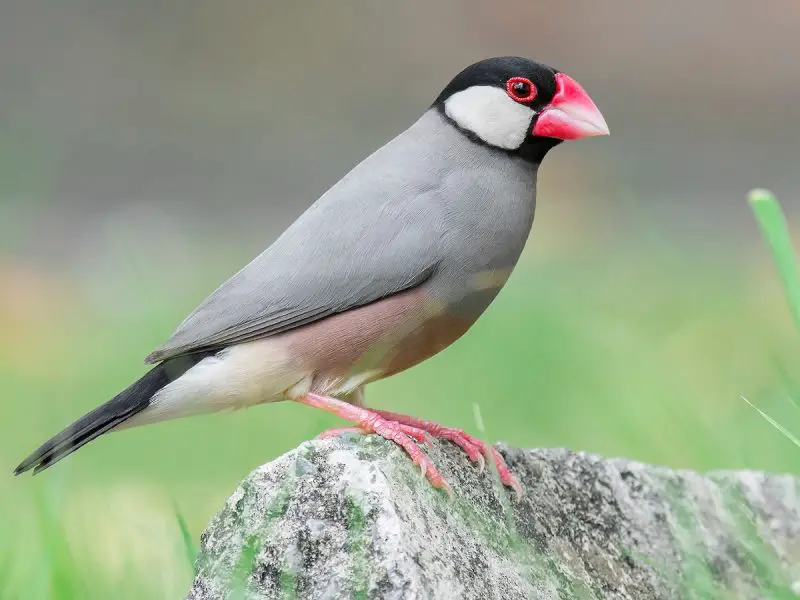
The Java Sparrow is a large, finch-like bird with a distinctive appearance—slate-gray body, black head, large pink bill, and white cheek patches. Adults measure about 5.5 to 6 inches in length and have a sturdy build suited for cracking hard seeds. Their pink legs and bright red eye rings further add to their striking look.
They primarily feed on grass seeds, grains, and occasionally fruits. Java Sparrows are social and often gather in small flocks, moving together while foraging on the ground or in low vegetation. Their calls are soft and chattering, and males produce a repetitive, metallic song during courtship.
Native to Java, Bali, and nearby islands, they were introduced to Hawaii in the 1960s and have since become established, particularly on Oʻahu. They are often found in parks, agricultural lands, and grassy fields, where food sources are plentiful.
Chestnut Munia (Lonchura atricapilla)
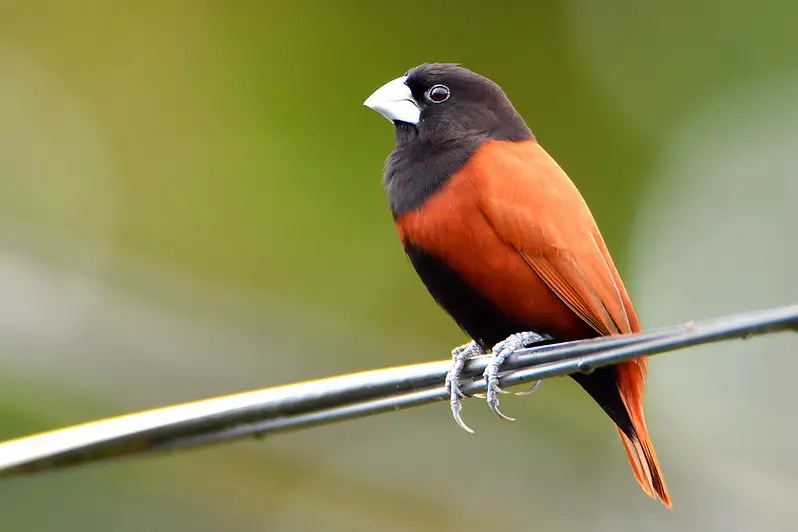
The Chestnut Munia is a small finch with a rich chestnut-brown body, black head, and short, conical silver-gray bill. Juveniles are entirely brown before acquiring adult plumage. Adults measure around 4.5 inches long and are stocky for their size, with strong legs adapted for perching on grass stems while feeding.
Their diet consists mainly of grass seeds, which they husk skillfully with their bills. They typically forage in flocks, moving through grassy fields and wetlands in search of food. During breeding season, they build neat, dome-shaped grass nests concealed among vegetation.
Originally from South and Southeast Asia, Chestnut Munias were introduced to Hawaii in the late 20th century. They are now found on several islands, especially in areas with tall grasses and wetlands, where they often mix with other small seed-eating birds.
Red Avadavat (Amandava amandava)
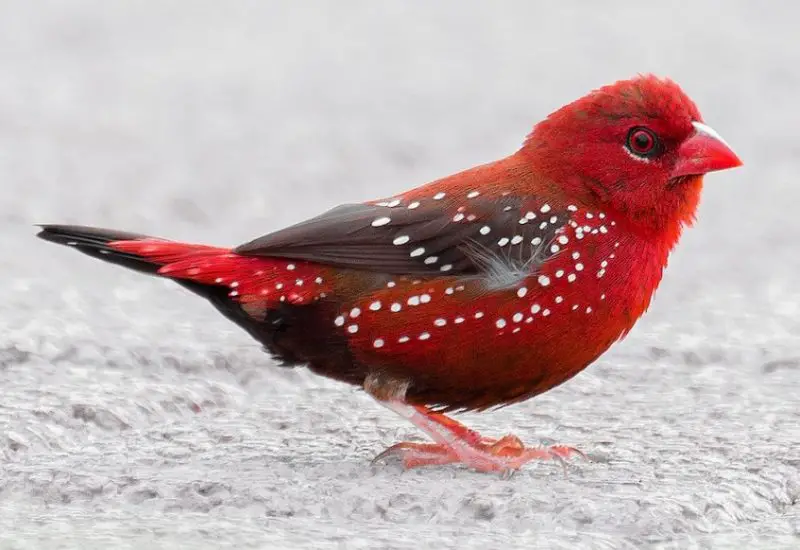
The Red Avadavat, also known as the Strawberry Finch, is a small, vibrant bird with brilliant crimson plumage speckled with white during the breeding season. Females and non-breeding males are brownish with subtle red tinges on the rump and face. Adults average about 4 inches in length and have short tails and stout, reddish bills.
They feed mainly on grass seeds but also consume small insects, especially when raising chicks. Red Avadavats are active and social, forming flocks outside the breeding season and producing high-pitched twittering calls. Breeding males perform display flights to attract females.
Native to tropical Asia, they were introduced to Hawaii in the late 20th century and are now found mainly on Oʻahu and Kauaʻi. They inhabit grassy fields, wetlands, and agricultural lands, often staying close to cover for protection from predators.
African Silverbill (Euodice cantans)
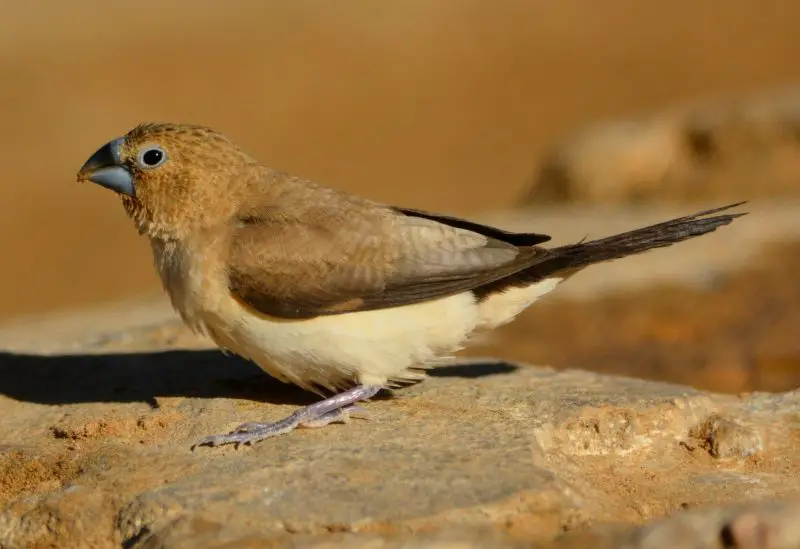
The African Silverbill is a small, pale finch with sandy-brown upperparts, whitish underparts, and a short, thick silver-gray bill. Its tail is relatively short, and the plumage is plain compared to more colorful finches. Adults measure about 4 inches in length and often appear in close-knit groups.
Their diet consists mainly of small grass seeds, which they husk efficiently. African Silverbills are gregarious, foraging in flocks and often seen perching together closely. Their soft, tinkling calls and gentle behavior make them less conspicuous than other introduced species.
Native to sub-Saharan Africa and parts of the Middle East, they were introduced to Hawaii in the 1970s. They are now found on several islands, favoring dry grassy areas, scrublands, and lightly wooded environments.
Lavender Waxbill (Estrilda caerulescens)
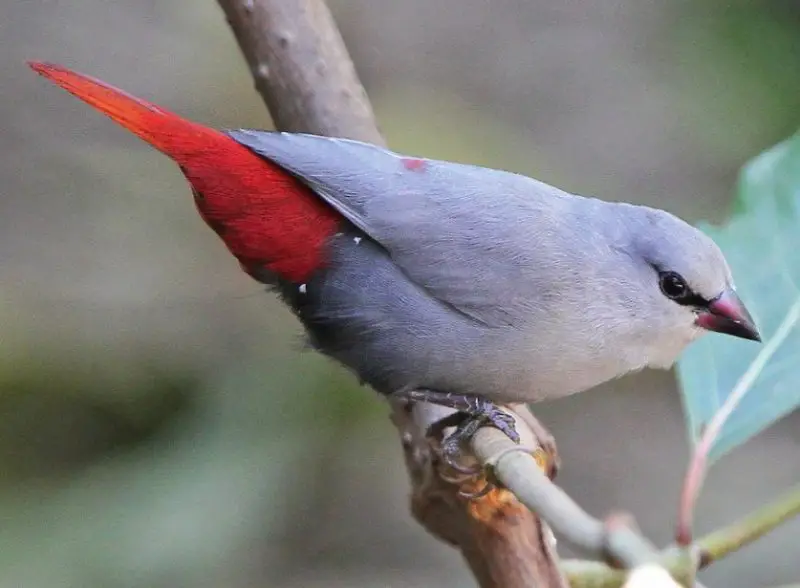
The Lavender Waxbill is a small, elegant finch with soft grayish-lavender plumage, a crimson rump, and a bright red bill. Its underparts are smooth and silky in appearance, and its long, fine tail adds to its delicate look. Adults measure about 4.5 inches long.
They primarily eat grass seeds, but also take small insects, especially during the breeding season. These birds are active and often forage low in vegetation, sometimes hanging upside down to reach seeds. Their calls are soft and high-pitched, often given while in motion.
Native to West Africa, Lavender Waxbills were introduced to Hawaii in the late 20th century and are now established mainly on Oʻahu. They inhabit grassy areas, gardens, and shrublands, where their subtle beauty makes them a prized sight for local bird enthusiasts.
Scaly-breasted Munia (Lonchura punctulata)
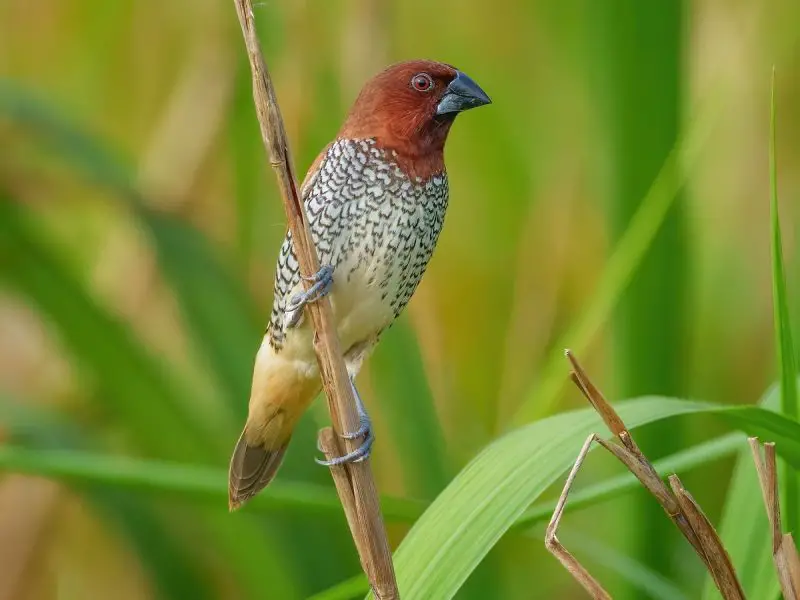
The Scaly-breasted Munia, also known as the Nutmeg Mannikin, is a small, stocky finch with a short, thick bill. Its most distinctive feature is the scale-like pattern on its white underparts, formed by dark feather edges, contrasting with its brown upperparts and head. Adults measure about 4.5 inches in length and have a compact body suited for seed feeding.
Their diet consists primarily of grass seeds, which they husk efficiently, though they may also take small insects. These birds are highly social and often seen in tight flocks, moving together between feeding sites. They produce soft, high-pitched calls and are generally quiet outside the breeding season.
Native to South and Southeast Asia, Scaly-breasted Munias were introduced to Hawaii in the late 19th century. They are now widespread across the main islands, thriving in grassy fields, farmlands, and parks.
House Sparrow (Passer domesticus)
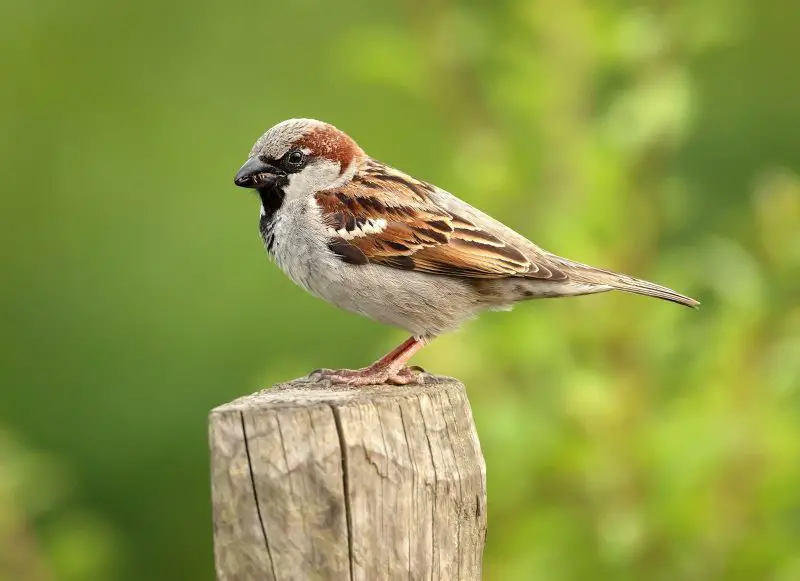
The House Sparrow is a familiar, medium-sized sparrow with a stout body and short tail. Males have a gray crown, chestnut nape, black bib, and streaked brown wings, while females and juveniles are plain brown and gray. Adults measure about 6 inches long and have a robust, seed-cracking bill.
House Sparrows feed mainly on grains and seeds but are opportunistic, eating insects and even scraps of human food. They are highly adaptable and often found near human settlements. Their chirping calls and social nature make them common around markets, parks, and gardens.
Introduced to Hawaii in the late 19th century, House Sparrows are now found on all major islands, especially in urban and agricultural areas. They are year-round residents and nest readily in building crevices and other man-made structures.
Hwamei (Garrulax canorus)
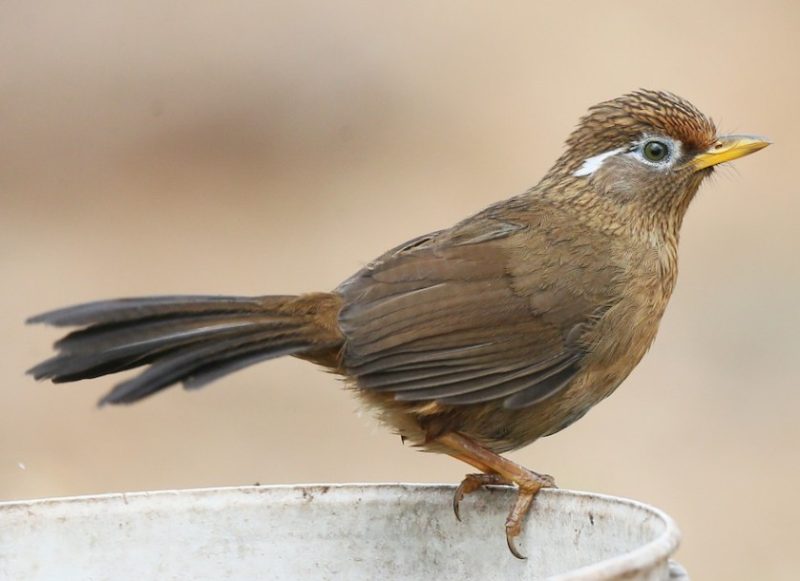
The Hwamei, also called the Melodious Laughingthrush, is a medium-sized songbird with warm brown plumage and a distinctive white eye-ring that extends backward in a line. It measures about 9 inches in length and has a strong, slightly curved bill adapted for foraging on the ground.
Hwameis are omnivorous, feeding on insects, fruits, and seeds. They are best known for their loud, melodious songs, which include a variety of whistles and warbles. Males often sing from exposed perches to mark territory.
Native to East Asia, Hwameis were introduced to Hawaii in the early 20th century and have established populations on several islands. They prefer forest edges, thickets, and scrublands, often staying hidden in dense vegetation.
Northern Mockingbird (Mimus polyglottos)
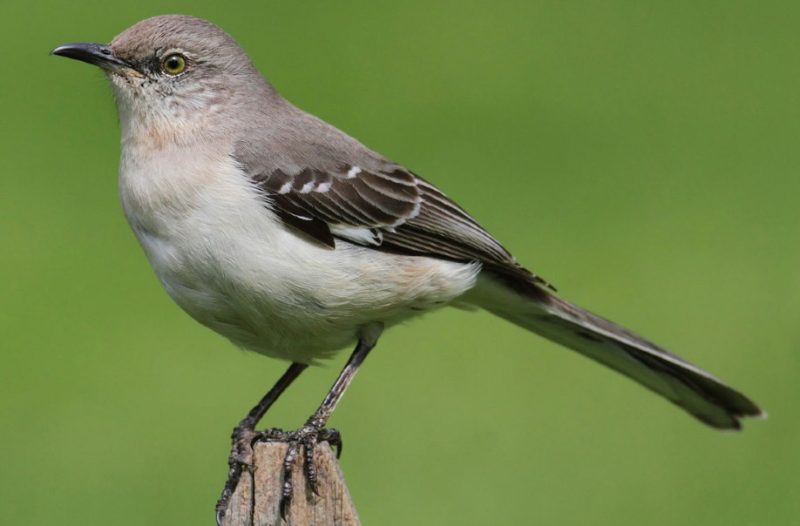
The Northern Mockingbird is a slender, gray songbird with long legs and tail, and distinctive white wing patches visible in flight. Adults measure about 9 to 10 inches in length. Their posture and alert demeanor make them easy to identify.
These birds are omnivorous, feeding on insects, fruits, and berries. They are famous for their remarkable vocal ability, often imitating the calls of other birds, animals, and even mechanical sounds. Males sing persistently during the breeding season to defend territories.
Introduced to Hawaii in the 1920s, Northern Mockingbirds are found mainly on Oʻahu and the Big Island, favoring open habitats, urban parks, and gardens. They are often seen perched conspicuously while scanning for food or rivals.
Barn Owl (Tyto alba)
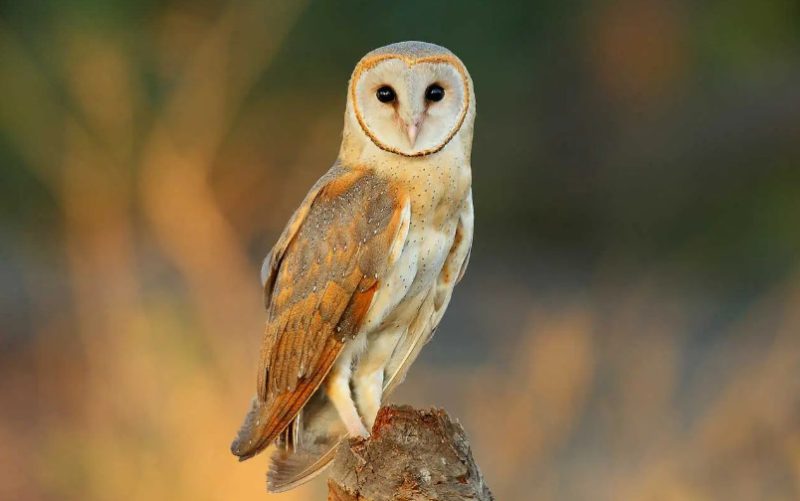
The Barn Owl is a medium-to-large nocturnal raptor with a distinctive heart-shaped facial disc, pale underparts, and mottled golden-brown and gray upperparts. Adults have long wings and legs, and measure about 13 to 15 inches in length with a wingspan up to 45 inches.
They hunt mainly at night, using their exceptional hearing to locate rodents and other small prey in darkness. Barn Owls fly silently due to specialized wing feathers that reduce noise. They nest in tree cavities, cliffs, and man-made structures.
Introduced to Hawaii in the 1950s for rodent control, Barn Owls are now established on all main islands. They inhabit open country, grasslands, and agricultural areas, often seen at dusk gliding low over fields.
Short-eared Owl (Asio flammeus sandwichensis)
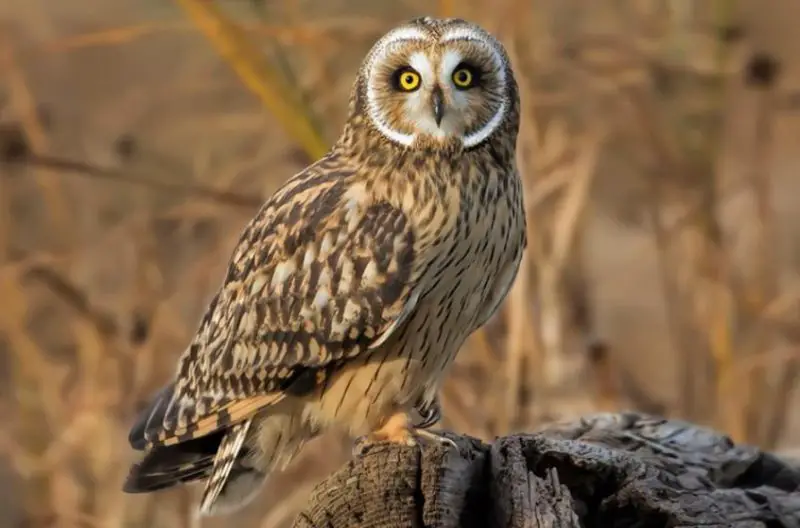
The Hawaiian Short-eared Owl, or Pueo, is a subspecies unique to the islands. It has mottled brown plumage, a round facial disc, and bright yellow eyes. Measuring about 13 to 17 inches in length with a wingspan of 33 to 43 inches, it is slightly smaller than some mainland counterparts.
Unlike most owls, the Pueo is often active during the day, especially at dawn and dusk. It hunts small mammals, birds, and insects, flying low over open fields with buoyant wingbeats. Nests are placed on the ground, hidden among grasses.
Pueo are native to Hawaii and have deep cultural significance in Hawaiian tradition, often regarded as a protector spirit. They are found in grasslands, shrublands, and high-elevation meadows across the islands.
FAQs about Birds in Hawaii
What are some endemic birds found only in Hawaii?
Hawaii is home to several endemic bird species, meaning they are found nowhere else in the world. Notable examples include the Hawaiian Goose (Nēnē), Hawaiian Hawk (‘Io), Hawaiian Coot (Fulica alai), Hawaiian Stilt (Himantopus mexicanus knudseni), and Hawaiian Gallinule (Gallinula galeata sandvicensis). These birds have adapted to Hawaii’s unique ecosystems and are an important part of the islands’ biodiversity.
Which seabirds are commonly seen around Hawaiian coasts?
Hawaiian waters host a variety of seabirds such as the Laysan Albatross, Black-footed Albatross, Red-footed Booby, Brown Booby, Great Frigatebird, White Tern, Sooty Tern, Brown Noddy, and Black Noddy. These species are often observed around offshore islets, cliffs, and open ocean areas. Many of them nest in large colonies on remote islands, making the Northwestern Hawaiian Islands a key habitat.
What migratory shorebirds visit Hawaii?
Hawaii is an important wintering ground for migratory shorebirds including the Pacific Golden-Plover, Ruddy Turnstone, Wandering Tattler, and other species. These birds travel long distances from breeding grounds in Alaska and Siberia and can be seen in wetlands, beaches, and open fields during the winter months.
Are there introduced bird species in Hawaii?
Yes, many bird species were introduced to Hawaii, either intentionally or accidentally. Common examples include the House Finch, Northern Cardinal, Red-crested Cardinal, Yellow-billed Cardinal, Japanese White-eye, Java Sparrow, Chestnut Munia, Red Avadavat, African Silverbill, Lavender Waxbill, Scaly-breasted Munia, House Sparrow, Hwamei, Melodious Laughingthrush, and Northern Mockingbird. These introduced species are now widespread and have adapted well to urban, agricultural, and natural habitats.
What owls are native to Hawaii?
Hawaii is home to two owl species: the Barn Owl (Tyto alba), which was introduced for rodent control but is now established, and the Hawaiian Short-eared Owl (Asio flammeus sandwichensis), locally called Pueo. The Pueo is a native subspecies, often active during the day, and inhabits grasslands, shrublands, and high-elevation meadows.
Which birds are commonly found in Hawaiian urban areas?
In urban and suburban areas, you are likely to see Rock Pigeons, Spotted Doves, Zebra Doves, Common Mynas, House Finches, Japanese White-eyes, and Northern Mockingbirds. These species are highly adaptable and often thrive in parks, gardens, streets, and residential neighborhoods.
Are any Hawaiian birds endangered or threatened?
Yes, several endemic species are considered vulnerable or endangered due to habitat loss, introduced predators, and other environmental pressures. Examples include the Hawaiian Goose (Nēnē), Hawaiian Hawk (‘Io), and Hawaiian Coot. Conservation programs, protected habitats, and predator management are critical for their survival.
How can I observe Hawaiian birds responsibly?
To observe Hawaiian birds responsibly, maintain a safe distance, avoid disturbing nests, and do not feed wild birds. Binoculars and field guides can enhance your birdwatching experience. Visiting designated wildlife refuges and remote islets under guided tours is a safe way to see seabird colonies without impacting sensitive habitats.
What is the best time to see migratory birds in Hawaii?
The best time to observe migratory birds, such as Pacific Golden-Plovers and Ruddy Turnstones, is during the fall and winter months, roughly from August to April. Resident birds like Japanese White-eyes, House Finches, and Mockingbirds can be observed year-round in various habitats.
How do seabirds like Albatrosses and Boobies hunt in Hawaiian waters?
Seabirds such as Laysan and Black-footed Albatrosses, Red-footed and Brown Boobies, and Great Frigatebirds hunt by flying over open waters and spotting prey near the surface. Boobies perform dramatic dives into the water to catch fish, while Frigatebirds often snatch prey mid-air or engage in kleptoparasitism, stealing food from other birds.


